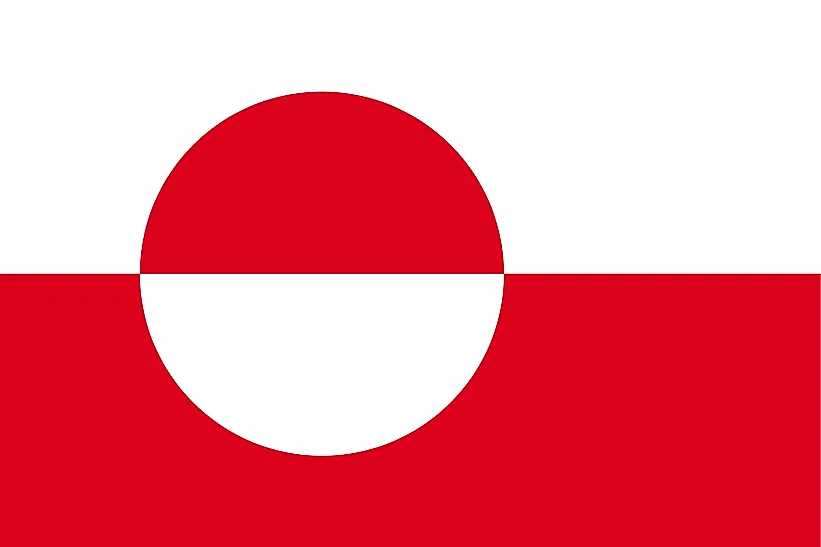
グリーンランド
| 大陸 | 米州 |
| 資本金 | ヌーク |
| 人口 | 57,728 |
| GDP | $2.17 億ドル |
| 一人当たりGDP | $37,600 |
| ダイヤルコード | +299 |
| ISOコード(2文字) | GL |
| ISOコード(3文字) | GRL |
グリーンランドについて
北大西洋と北極海に挟まれた広大な北極圏に広がる、世界最大の島でありデンマーク王国の自治領であるグリーンランドへようこそ。216万平方キロメートルという広大な国土の大部分は、地球上で2番目に大きな氷床で覆われており、沿岸部だけが永久氷に覆われていない。グリーンランドには、主に南西部の海岸沿いに約5万6,000人が住んでおり、イヌイットの文化的伝統と北欧の影響が融合した独自の文化を維持している。氷に覆われた現実とは対照的なこの領土の名前は、10世紀に赤毛のエリックが北欧からの入植者を誘致するために戦略的なマーケティングを行ったことに由来する。今日、この北極圏の巨人は気候変動の劇的な影響に直面しながら、地球上で最も困難な環境のひとつである北極圏で、自治権の強化と持続可能な開発への道を歩んでいる。
地理的特徴と自然の美しさ
グリーンランドの地理は、島の約80%を覆い、水深3,000mにも達する巨大なグリーンランド氷床が支配する、極限状態の研究である。世界の淡水の約10%を蓄えるこの太古の氷塊は、険しいフィヨルドに囲まれた真っ白な内陸の高原を作り出し、そこに人間の居住地が発達してきた。氷のない沿岸地域は、山、谷、そして何千もの島々からなるドラマチックな景観を見せ、44,000km以上にも及ぶ世界で最も複雑な海岸線を形成している。
島の最北端であるモリス・ジェサップ岬は、北極点からわずか740kmの地点にあり、グリーンランドは実質的に最北の陸地である。この極北の位置にあるため、季節による光の変化が激しく、北極圏より上では夏は白夜、冬は極夜となる。南部の地域は亜寒帯気候に属し、極北の地域は極寒で降水量の少ない真の極地となる。
グリーンランドの国立公園は、島の北東部全体をカバーし、ほとんどの国よりも広い972,000平方キロメートルという世界最大の国立公園です。この広大な保護地域には、ホッキョクグマ、ジャコウウシ、ホッキョクギツネ、数多くの海鳥など、多様な北極圏の野生生物が生息している。沿岸海域には、アザラシやセイウチから、特徴的な螺旋状の牙を持つイッカクを含む数種のクジラまで、海洋生物が生息している。
島の氷床はヌナタック(氷の上に突き出た山頂)で区切られ、沿岸の山々はフィヨルドから劇的にそびえ立ち、その一部は100km以上も内陸に伸びている。東海岸のスコレスビー・スンドは世界最大のフィヨルドシステムを形成しており、その支流は350km以上に及ぶ。太古の氷河によって削り取られたこれらの深い水路は、活動中の氷河から削り取られたそびえ立つ氷山が紺碧の海を雄大に漂う、息を呑むような海の風景を作り出している。
気候変動はグリーンランドの景観を急速に変化させており、氷床の質量は加速度的に減少している。この融解によって、氷の表面に雪解け水の川や湖ができたり、主要な氷河の分水現象が頻繁に起こるようになったりと、壮大だが気になる現象が起きている。ユネスコの世界遺産に登録されているイルリサット・アイスフィヨルドでは、世界で最も活発な氷河のひとつであるセルメク・クジャレク氷河が巨大な氷山をディスコ湾に排出する、このダイナミックなプロセスを見ることができる。
文化遺産と伝統
グリーンランドの文化は、古代のイヌイットの伝統と北欧の影響が融合した魅力的なもので、地球上で最も厳しい環境のひとつであるグリーンランドに何世紀にもわたって適応し、独自のアイデンティティを確立してきました。この文化的遺産は、言語、芸術、狩猟の習慣、コミュニティの祝祭などを通して表現され、現代世界におけるグリーンランドのアイデンティティを定義し続けている。
グリーンランド語のカラアリスートはイヌイット・ユピク・ウナンガン語族に属し、2009年にグリーンランド唯一の公用語となった。この多義語は、ヨーロッパの言語では文章全体が必要になるような内容を、ひとつの単語で表現することができ、イヌイットの世界観と北極圏の環境との関係を体現している。ほとんどのグリーンランド人は、デンマーク語やしばしば英語も話すバイリンガルかトリリンガルであり、言語的に豊かな社会を形成している。
伝統的な狩猟と漁業は、経済活動として、また文化的アイデンティティの表現として、グリーンランド文化の中心であり続けている。アザラシ、クジラ、ジャコウネコ、トナカイの狩猟は、伝統的な知識とともに近代的な技術を取り入れながらも、何千年にもわたって培われてきた慣習を守り続けている。これらの活動は、何世代にもわたって受け継がれてきた持続可能性の原則と動物への敬意によって管理されている。
グリーンランドでは芸術の伝統が盛んで、トゥピラク彫刻(伝統的に骨、角、象牙で作られる、霊的な人物を描いた小さな彫刻)や、複雑なビーズ細工やアザラシの皮を使った民族衣装の制作など、独特の形態が見られる。イヌイットの伝統的な表現形態であるドラム・ダンスと喉歌は、文化復興活動の一環として復活を遂げた。現代のグリーンランドのアーティストたちは、こうした伝統的な要素と現代的な形式を融合させ、進化するアイデンティティをダイナミックに表現するようになっている。
音楽は現代のグリーンランド文化において重要な役割を果たしており、伝統的なイヌイット・ドラムのリズムと現代的な影響を融合させた独自のサウンドを生み出している。伝統的なテーマと現代的な課題の両方を取り上げたカラアリスート語の歌詞を持つポピュラー音楽を創作しているバンド、ナヌークは、この融合を象徴している。毎年開催されるヌーク・ノルディック・カルチャー・フェスティバルは、北極圏全域からパフォーマーを集め、この活気ある文化シーンを紹介する。
共同体はグリーンランド人の生活の中心にあり、協力と分かち合いという伝統的な価値観が社会組織に影響を与え続けている。6月21日のナショナル・デー(夏至祭)は、毎年行われる最も重要な祭典であり、伝統的な服装、食べ物、スピーチ、文化的なパフォーマンスなどが行われ、集団としてのアイデンティティとグリーンランドの伝統に対する誇りが高まります。
歴史の旅
グリーンランドの歴史は、最古の古エスキモー文化から、デンマークや広い世界との関係をナビゲートする自治領としての現在の地位まで、数千年に及ぶ。この歴史的な旅は、極限状態に対する人間の驚くべき適応と、先住民とヨーロッパ人の複雑な相互作用を反映している。
考古学的証拠によると、グリーンランドに人類が定住したのは、現在のカナダから相次いで移住した約4,500年前にさかのぼる。現代のイヌイットの祖先であるトゥーレ文化は紀元1200年頃に到達し、カヤック、ウミアック(オープン・スキン・ボート)、トグリング・ハープーンなど、北極圏での生存能力に革命をもたらした高度な狩猟技術をもたらした。
ヨーロッパ人との接触は、紀元985年頃、赤毛のエリックがアイスランドからグリーンランド南西部に入植した北欧人の入植から始まった。これらの北欧人の植民地は500年近く存続し、農業と交易経済を発展させたが、15世紀に謎の消滅を遂げた。おそらく気候の冷え込み、イヌイットとの紛争、あるいはヨーロッパとの交易の衰退による経済的孤立が原因であろう。
デンマークとノルウェーの植民地化は、1721年に宣教師ハンス・エゲデ(Hans Egede)が現在のヌーク近郊に入植地を設立したことから始まりました。その後数十年でデンマークの支配は正式になり、海岸沿いに交易所が設けられ、ルター派のキリスト教が徐々にイヌイットの間に広まっていきました。
19世紀から20世紀初頭にかけては、伝統的なイヌイットのライフスタイルがヨーロッパの貿易、宗教、統治にますます影響されるようになり、大きな変化をもたらした。1953年の憲法改正により、グリーンランドは植民地ではなくデンマーク国内の郡として編入され、グリーンランド人にデンマーク市民権とデンマーク議会への代表権が与えられた。
20世紀後半には自治権拡大への動きが加速し、1979年には内政に関する権限を持つグリーンランド議会(イナツィサルトゥット)と政府を設立する自治法が制定された。このプロセスは2009年の自治法に結実し、グリーンランド人を国際法上の別個の民族として認め、カラアリスートを公用語とし、グリーンランド人がこの方向を選択した場合、最終的に独立する道筋を作った。
現代の経済状況
今日のグリーンランドは、北極圏の開発と自給率の向上という独自の課題を克服しながら、伝統的な活動と近代的な部門とのバランスをとる混合経済を発展させてきた。グリーンランドの経済構造は、その天然資源と、地理、気候、人口の少なさによる制約の両方を反映している。
漁業はグリーンランド経済の基幹であり、輸出の90%以上を占めている。島を囲む冷たく栄養豊富な海域は、エビ、グリーンランドオヒョウ、タラ、ズワイガニなどの貴重な商業種を育んでいます。グリーンランド最大の企業であるロイヤル・グリーンランド社は、これらの海洋資源を加工し、世界的に販売している。これらの漁業の持続可能な管理は、長期的な経済の安定にとって極めて重要である。
観光業は、グリーンランドの壮大な景観、独特の文化、北極圏の野生動物に惹かれて訪れる人が多く、第2の経済の柱として大きく成長している。この分野では、探検クルーズ、氷床へのヘリコプター・ツアー、犬ぞりアドベンチャー、オーロラ鑑賞など、大量観光よりも価値の高い体験に重点を置いている。空港拡張プロジェクトなどのインフラ整備は、環境と文化の完全性を維持しながら、継続的な成長を支えることを目指している。
鉱業は歴史的に重要であり、将来的にも重要な意味を持つ可能性がある。現在、アパルトークではルビーとピンクサファイアの採掘が行われている。レアアース、ウラン、石油、ガスの探鉱も続けられているが、開発には経済的利益と環境問題や地域社会の要望とのバランスが必要である。2009年に制定された自治法により、地下資源のグリーンランド帰属権が確立され、将来の採掘による利益は主にグリーンランド領土内に留まることになった。
伝統的な狩猟や手工芸品は、特に正式な雇用機会が限られている小規模な集落では、生計の糧となっている。これらの活動は、収入を生み出すだけでなく、文化的慣習を維持し、グリーンランドの食生活とアイデンティティにおいて重要な位置を占める郷土料理を提供している。
経済が発展しているにもかかわらず、グリーンランドはデンマークからGDPの約3分の1を占めるブロック・グラントを毎年受け取り続け、必要不可欠な公共サービスを賄っている。持続可能な経済成長を通じてこの依存度を減らすことが、自治政府当局の重要な目標であるが、人口が少なく分散していることや交通費が高いことなど、地理的な課題が構造的な根強い課題となっている。
国際関係とグローバルポジション
デンマーク王国内の自治領であるグリーンランドは、国際情勢においてユニークな地位を占めている。デンマークが国防と外交政策の権限を保持する一方で、グリーンランドが直接関心を寄せる分野では、自国の代表としての活動が増えている。この配置は、グリーンランドがより大きな自治権を主張するにつれて進化し続ける複雑な外交状況を作り出している。
気候変動によって新たな航路が開拓され、資源へのアクセスが可能になるにつれ、北極圏におけるグリーンランドの戦略的位置は、地政学的に新たな重要性を帯びてきた。グリーンランドは北極評議会に参加し、デンマークやフェロー諸島と代表権を共有しながらも、環境保護、先住民の権利、持続可能な開発に関する独自の利益を主張するようになり、北極圏の統治において重要な発言力を持つようになった。
米国との関係は、グリーンランド北西部にあるトゥーレ空軍基地(米国最北の軍事施設)を中心に、歴史的な深みと現代的な重要性を持っている。1951年に締結されたデンマークとアメリカの防衛協定は、特に基地を設置するためにイヌイット族が強制移住させられたという歴史的な問題に関して、時折緊張の種となってきた。2019年、ドナルド・トランプ大統領(当時)がグリーンランド購入に関心を示したことで、グリーンランドの戦略的価値に国際的な注目が集まった。
グリーンランドは、グリーンランド、カナダ、アラスカ、チュコトカ(ロシア)の約18万人のイヌイットを代表するイヌイット循環極評議会を通じて、北極圏の他のイヌイット地域と独自の関係を築いてきた。この国境を越えた協力関係は、国際的な場における環境保護、文化保護、先住民族の権利に焦点を当てている。
グリーンランドが世界平均の2倍の速度で温暖化に見舞われる中、気候外交はグリーンランドの国際的な関与の中心となっている。グリーンランドの代表は、国連の気候変動会議において、気候変動が北極圏のコミュニティや生態系に与える影響について直接証言し、緩和策と適応策の両方を提唱している。
経済外交は、グリーンランドがデンマーク国外への投資や開発パートナーシップを模索する中で拡大してきました。EU(ただし、グリーンランドは1985年にEUの前身から脱退している)、アイスランド、そして中国や韓国を含むアジア諸国との関係は、漁業、観光、潜在的な資源開発に焦点が当てられている。
ご存知でしたか?
- 世界最大の島であるにもかかわらず、グリーンランドには町や集落を結ぶ道路がない。
- グリーンランド氷床は、完全に溶けた場合、世界の海面を約7.4メートル上昇させるほどの水を含んでいる?
- グリーンランドで3番目に大きな町イルリサットには、人間よりもそり犬の数が多い。
- グリーンランド語には、雪や氷をさまざまな形で表現する言葉が50語ほどあるが、これは日常生活におけるこれらの要素の文化的重要性を反映しているのだろうか?
- グリーンランドには、その巨大な国土にもかかわらず、グリーンランドの社会と開発に特に関連した科目を扱う大学がヌークにあるイリシマトゥサルフィク(グリーンランド大学)1校しかない。
結論
グリーンランドは、地球上で最も困難な景観のひとつにおいて、文化的回復力、環境適応力、政治的進化の顕著な例として存在している。壮大な氷山とフィヨルド、活気に満ちたイヌイットの遺産、そしてデンマークとの複雑な関係を持つこの広大な北極圏の島は、伝統的な生活様式と現代的な願望、ローカルな統治と世界的な重要性、気候変動に対する脆弱性と持続可能な未来を切り開く決意など、対照的で魅力的な研究を提供している。
グリーンランドは21世紀を航海する中で、並外れた挑戦とユニークな機会の両方に直面している。気候変動による物理的環境の急速な変化は、伝統的な慣習に直接的な脅威をもたらすと同時に、新たな経済的可能性を開く可能性を秘めている。現在進行中の自決に向けた旅は、政治構造や国際関係の形を変え続けている。このような変化の中でも、グリーンランド社会を数千年にわたり特徴づけてきた回復力と適応力は、不確実な未来へのアプローチにおいて依然として明らかである。
グリーンランドを訪れる幸運な旅行者には、息をのむような美しい自然だけでなく、現代の北極圏の複雑なアイデンティティを受け入れながら、文化遺産の保護に積極的に取り組んでいる社会を目の当たりにする機会もあります。巨大な氷山を照らす真夜中の太陽から、沿岸の小さなコミュニティーの温かいもてなし、古くからの狩猟の伝統から最先端の気候研究まで、グリーンランドは、過去と未来、自然と人間性、挑戦と機会が並はずれた形で融合する世界を提示している。





